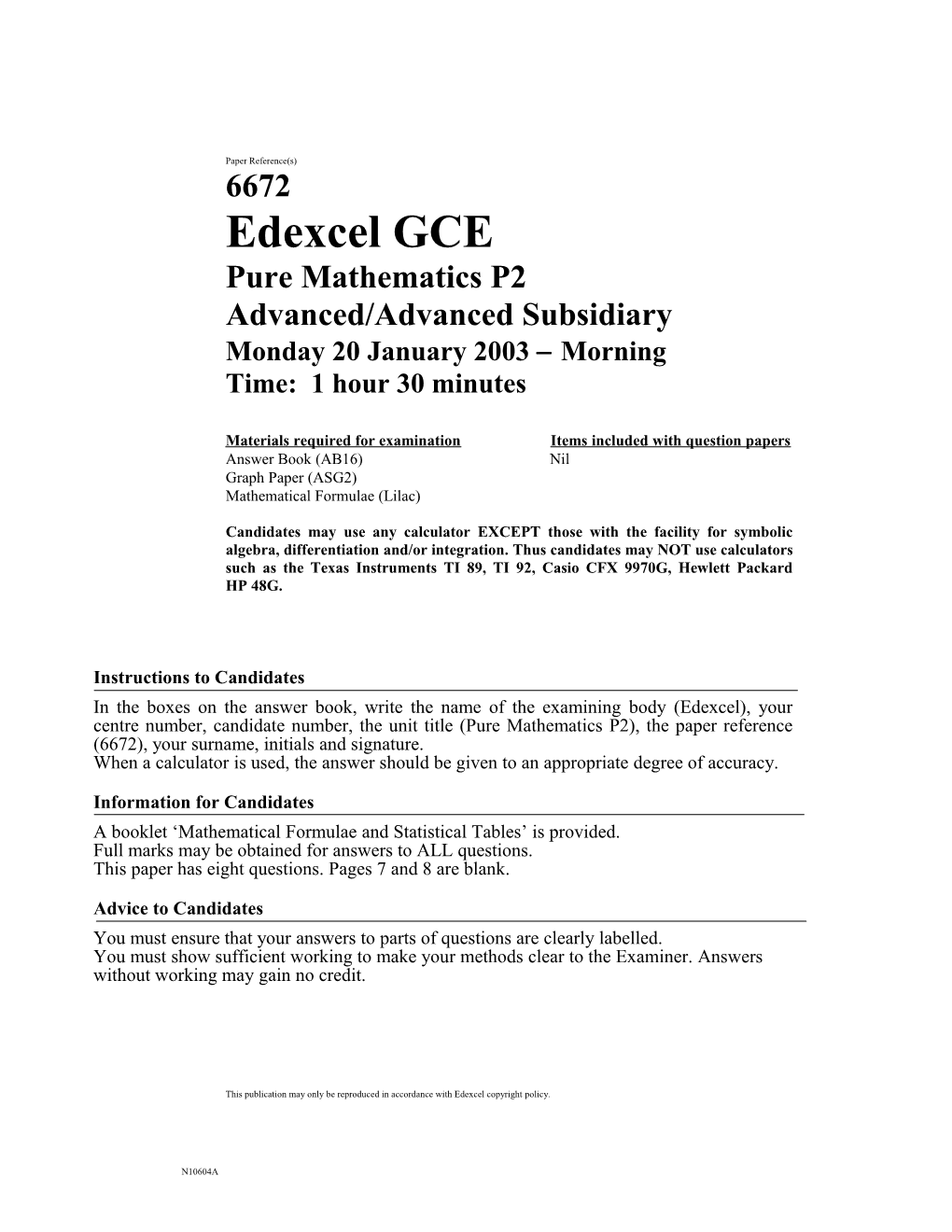Paper Reference(s)
6672
Edexcel GCE
Pure Mathematics P2
Advanced/Advanced Subsidiary
Monday 20 January 2003 Morning
Time: 1 hour 30 minutes
Materials required for examination Items included with question papers
Answer Book (AB16) Nil
Graph Paper (ASG2)
Mathematical Formulae (Lilac)
Candidates may use any calculator EXCEPT those with the facility for symbolic algebra, differentiation and/or integration. Thus candidates may NOT use calculators such as the Texas Instruments TI 89, TI 92, Casio CFX 9970G, Hewlett Packard HP 48G.
Instructions to Candidates
In the boxes on the answer book, write the name of the examining body (Edexcel), your centre number, candidate number, the unit title (Pure Mathematics P2), the paper reference (6672), your surname, initials and signature.
When a calculator is used, the answer should be given to an appropriate degree of accuracy.
Information for Candidates
A booklet ‘Mathematical Formulae and Statistical Tables’ is provided.
Full marks may be obtained for answers to ALL questions.
This paper has eight questions. Pages 7 and 8 are blank.
Advice to Candidates
You must ensure that your answers to parts of questions are clearly labelled.
You must show sufficient working to make your methods clear to the Examiner. Answers
without working may gain no credit.
This publication may only be reproduced in accordance with Edexcel copyright policy.
Edexcel Foundation is a registered charity. ©2003 Edexcel
N10604A
1.Express + as a single fraction in its simplest form.
(6)
2.The first three terms in the expansion, in ascending powers of x, of (1 + px)n, are 1 – 18x + 36p2x2. Given that n is a positive integer, find the value of n and the value of p.
(7)
3. (a)Sketch the graph of y = 2x + a, a > 0, showing the coordinates of the points where the graph meets the coordinate axes.
(2)
(b)On the same axes, sketch the graph of y = .
(1)
(c)Explain how your graphs show that there is only one solution of the equation
x2x + a 1 = 0.
(1)
(d)Find, using algebra, the value of x for which x2x + 1 1 = 0.
(3)
4.Figure 1
y
O14x
Figure 1 shows part of the curve with equation y = 1 + . The shaded region R, bounded by the curve, that x-axis and the lines x = 1 and x = 4, is rotated through 360 about the x-axis. Using integration, show that the volume of the solid generated is (5 +ln 2).
(8)
5.Figure 2
y
10
2 O 10 12x
Figure 2 shows the cross-section of a road tunnel and its concrete surround. The curved section of the tunnel is modelled by the curve with equation y = 8, in the interval 0 x 10. The concrete surround is represented by the shaded area bounded by the curve, the x-axis and the lines x = 2, x = 12 and y = 10. The units on both axes are metres.
(a)Using this model, copy and complete the table below, giving the values of y to 2 decimal places.
x / 0 / 2 / 4 / 6 / 8 / 10y / 0 / 6.13 / 0
(2)
The area of the cross-section of the tunnel is given by .
(b)Estimate this area, using the trapezium rule with all the values from your table.
(4)
(c)Deduce an estimate of the cross-sectional area of the concrete surround.
(1)
(d)State, with a reason, whether your answer in part (c) over-estimates or under-estimates the true value.
(2)
6.The curve with equation y = ln 3x crosses the x-axis at the point P (p, 0).
(a)Sketch the graph of y = ln 3x, showing the exact value of p.
(2)
The normal to the curve at the point Q, with x-coordinate q, passes through the origin.
(b)Show that x = q is a solution of the equation x2 + ln 3x = 0.
(4)
(c)Show that the equation in part (b) can be rearranged in the form x = .
(2)
(d)Use the iteration formula xn + 1 = , with x0 = , to find x1, x2, x3 and x4. Hence write down, to 3 decimal places, an approximation for q.
(3)
7.(a)Express sin x + 3 cos x in the form R sin (x + ), where R > 0 and 0 < < 90.
(4)
(b)Show that the equation sec x + 3 cosec x = 4 can be written in the form
sin x + 3 cos x = 2 sin 2x.
(3)
(c)Deduce from parts (a) and (b) that sec x + 3 cosec x = 4 can be written in the form
sin 2x – sin (x + 60) = 0.
(1)
(d)Hence, using the identity sin X – sin Y = 2 cos , or otherwise, find the values of x in the interval 0 x 180, for which sec x + 3 cosec x = 4.
(5)
N10604A1Turn over
8.Figure 3
y
(0, c)
O(d, 0)x
Figure 3 shows a sketch of the curve with equation y = f(x), x 0. The curve meets the coordinate axes at the points (0, c) and (d, 0).
In separate diagrams sketch the curve with equation
(a)y = f1(x),
(2)
(b)y = 3f(2x).
(3)
Indicate clearly on each sketch the coordinates, in terms of c or d, of any point where the curve meets the coordinate axes.
Given that f is defined by
f : x 3(2x ) 1, x ℝ, x 0,
(c)state
(i)the value of c,
(ii)the range of f.
(3)
(d)Find the value of d, giving your answer to 3 decimal places.
(3)
The function g is defined by
g : x log2 x, x ℝ, x 1.
(e)Find fg(x), giving your answer in its simplest form.
(3)
END
N16316RA1
